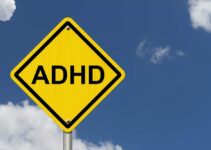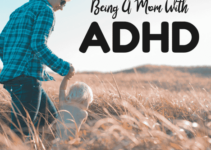This resource was created by Dr Ree Langham PhD: a child psychologist with over a decade experience writing and editing medical articles.
At a Glance:
- The brains of children with ADHD are different.
- This can make learning challenging.
- Parental involvement plays a significant role in academic achievement.
- Creative techniques can help children with ADHD be successful in the classroom.
Table of Contents
ADHD in School Age Children
Did you know that approximately 11% (about 6 million) school-age children from the ages of 4-17 are diagnosed with ADHD?[1]
Well, it’s true. And, even more significant is that this statistic has increased 42% since 2003 with males (13%) being diagnosed with it more frequently than females (6%).[2]
In fact, one recent study that tracked children with ADHD into early adulthood found that young adults (in their 20s) with ADHD are less likely to have graduated from high school and entered college.[3]
In addition, a 2011 CDC report suggests that young adults with ADHD have a harder time developing and maintaining friendships, and lower job performance reviews, than those without it.[4]
Moreover, according to a 2003 Board of Education report, adolescents with ADHD are more likely to fall behind in their classes than their non-ADHD peers.[5]
The truth is, our educational system can be challenging for children with attention deficit hyperactivity disorder (ADHD). However, with persistence, patience, and a successful plan, your child can be successful in the classroom.
What are the symptoms?
Children with ADHD can exhibit a variety of symptoms like:
- constant daydreaming,
- fidgetiness, and/or
- an inability to follow instructions.
It is important to note that ADHD can affect children in different ways, so it may look different for one child in the classroom than another.
The good news is that with a little extra effort, you can help your child reduce or eliminate his or her ADHD symptoms.
First, you must identify how this disorder affects your child’s behavior. Then, you can develop valuable techniques to address your child’s behavioral problems.
There are many down-to-earth, easy approaches that you and your child’s teachers can apply to help manage his or her ADHD symptoms.
And, with these easy-to-follow instructions, your child will be well on their way to academic success!
9 Ways to Help Your Child with ADHD be Successful at School
1. Prepare Your Child for School

You can ensure academic success by preparing your child for school.
What does that mean?
It starts with providing your child with a wholesome breakfast – one that prepares him or her for a productive day at school.
Children who eat a healthy breakfast are more focused, have more energy, and perform better in class.
If you want to combat a lack of focus, poor retention (memory), and/or inattention, provide your child with a good breakfast that is low in salt, sugar, and fat, and high in fiber, protein, whole grains, and vitamin C.
If mornings feel rushed at your house, then a combo of yogurt, fresh fruit and nuts or oatmeal with nuts and berries can work well.
And, if you don’t even have time for that, well, some schools provide health breakfasts for children before their first classes.
You can also prepare your ADHD child for school by making sure they get enough sleep at night.
For children to be alert and focused, they need between 8 and 9 hours of sleep each night.
Unfortunately, between early start times at school, packed school schedules, a mountain of homework, sports, extracurricular activities, and friends, there isn’t much time left for sleep.
And, guess what? Inadequate sleep eventually leads to poor short-term memory, lack of concentration, distractibility, procrastination, and low grades.
Key Points:
- Make sure your child eats a healthy breakfast
- Make sure your child gets enough sleep
2. Get Involved

Another way to boost your child’s success at school is to become involved by volunteering at their school.
When you volunteer, it shows how invested you are in your child’s education.
Just remember that while some children love for their parents to be involved in school activities, others may not respond positively to it. They may cringe at the thought of their parents “hanging around” at their school.
So, what should you do?
Pay attention to your child’s cues.
If he or she hides from you when you come to school, then opt for staying “behind the scenes,” while you volunteer – i.e. organizing field trips, working in the office, etc.
But, if your child likes having you around, take an active role in their activities, such as acting as a chaperone on field trips and/or at dances.
It can be helpful to reassure your child that you aren’t volunteering to “spy on him or her.” Rather, explain to him or her that you are only volunteering to ease the burden on school staff.
Key Points:
- Volunteer at your child’s school in order to boost their success.
3. Collaborate with Your Child’s Teachers

You are your child’s most important advocate.
Collaborating with your child’s teacher can help them be more successful in the classroom. Although teachers can help children with ADHD achieve certain educational markers and milestones, parental involvement is essential to boosting a child’s academic success.
You can maximize your child’s learning potential by working with their teachers and reinforcing what they are learning in class.
There are many ways you can work with your child’s teachers, so your child stays “on-track.”
Both you and your child’s teachers can positively affect your child’s education by putting your heads together and developing techniques that can combat their specific academic challenges.
So, how can you work with your child’s teachers?
Keeping the lines of communication open with the teachers can help increase your child’s success in the classroom.
More specifically, verbalize your child’s needs to school staff , whether it’s the teacher, principal, guidance counselor, or social worker.
Don’t forget to also listen to your child’s teachers, because they may have valuable insight into your child’s challenges.
Try to keep this collaboration constructive, positive, and productive.
And remember, the goal is to figure out the best way to help your child achieve his or her goals in the classroom.
Key Points:
- Work with your child’s teachers in order to develop techniques that can combat their specific challenges
- Verbalize your child’s needs to school staff
- Listen to your child’s teachers
- Stay constructive, positive and productive
4. Develop a Behavioral Plan – And Stick to It!

If your child has ADHD, you can boost their success in the classroom by developing a behavioral plan for him or her – and sticking to it!
Contrary to popular belief, children with ADHD can behavior appropriately in the classroom. They just need consistency, structure, and easy-to-follow instructions.
Your child will perform better at school if he or she knows what to expect from day to day.
To ensure the highest success, develop a plan with your child’s teachers.
FYI: Children with this disorder do best with clear, realistic goals, praise for accomplishments, positive reinforcement, and meaningful incentives (rewards).
So create a behavioral plan that involves incentives to celebrate your child’s accomplishments at school.
Key Points:
- Develop a behavioral plan for your child
- Make sure the plan is consistent, structured, and easy to follow
- Involve your child’s teacher in the plan
- Give plenty of praise and meaningful rewards
5. Remove Distractions

Children with ADHD are easily distracted by a variety of stimuli such as images, sounds, movement, and their own thoughts.
As a result, they tend to miss valuable information shared in class.
Moreover, it’s hard for these children to become or stay focused for any length of time, which makes completing classroom tasks and homework assignments challenging.
They may appear to be paying attention in class when they are actually daydreaming or zeroing in on whatever has briefly caught their attention.
Here are some good ways to improve your child’s performance in the classroom:
- Ask for your child to be placed away from distractions such as chatty children, a door that opens and closes, or a window.
- When your child returns home from school, make sure he or she has plenty of breaks while working on homework assignments.
- Putting pets and electronic devices in another room can also be helpful.
- Breaking longer homework assignments into small sections so your child doesn’t become bored and lose focus can help your them finish their homework.
- Allow your child to move around while studying or completing schoolwork.
- Write down important information where your child can easily access it.
Key Points:
- Ask that your child be placed away from distractions in the classroom
- Keep distractions away from your child during homework time
- Give your child lots of breaks and opportunities to move while working on tasks
6. Get a Grip On Your Child’s Impulsivity

Children with ADHD can have a hard time accurately assessing situations.
They may act prematurely before thinking things through, leading to misunderstandings between classmates.
In addition, they may appear to lack impulse control, causing both teachers and classmates to view them as disobedient, disruptive, and/or aggressive.
Impulsivity is considered one of the most disruptive ADHD symptoms in children – especially in a classroom setting.
If your child is prone to impulsivity, you can curb these impulses as follows:
- Address infractions as soon as they occur
- Acknowledge good behavior in front of others
- Create a daily checklist of tasks to “check-off” once completed
- Offer him or her some control over what happens during the day.
Structure can provide your child with a sense of calm and control over his or her daily existence, thus improving focus and boosting his or her success in the classroom.
Key Points:
- Address infractions as soon as they occur
- Acknowledge good behavior in front of others
- Create a daily checklist of tasks to “check-off” once completed
- Offer your child some control over what happens during the day.
7. Break Down Instructions

Did you know that children with ADHD have a hard time following instructions?
It is a significant issue for many children with this condition.
So, even if your child appears to understand what he or she is learning in class (i.e. taking notes, etc.), they still may not be able to complete classroom or homework tasks.
What does having a hard time following instructions look like in a child with ADHD?
Well, it may involve missing steps, turning in incomplete assignments, getting the concept of assignment wrong altogether, and/or doing something completely different because it’s more stimulating.
The best way to help your child with ADHD follow instructions better is to break them down into smaller increments.
Don’t forget to redirect your child if he or she becomes distracted.
Explain the instructions in a way that your child can understand, then allow him or her to complete the first task.
Once they have completed that task, explain the next section, then give them another task to work on.
Continue to do this until he or she has completed the entire assignment.
If your child gets “off-track,” calmly but firmly remind him or her what the focus is.
And, if possible, use colored markers to write down the instructions in BIG letters on a chalkboard, so it will attract your child’s attention.
Key Points:
- Break down instructions into smaller increments
- If necessary, explain the increments one at a time
- Help your child stay on track
- Use colored markers to write instructions in big letters on a chalkboard[/pullquote]
8. Curb Hyperactivity

Children with ADHD can be quite “busy.” In other words, they are in continuous motion most of the time.
For most of these children, staying in their seats is nearly impossible.
If your child has a habit of twisting and turning, jumping, kicking, moving around and/or fidgeting, it can interfere with the learning process. However, there are ways to effectively combat hyperactivity while still allowing movement.
For example, a teacher could add movement into the classroom by breaking the class into 15-minute segments with various workstations focusing on different parts of the lesson. Each workstation could consist of games or science experiments, or word problems that teams could solve based on provided clues.
The key is being creative and finding a way to teach all of the students.
Important: A child with ADHD is calmer and more focused when he or she can “act on” their urges to move.
Other ways to combat hyperactivity include:
- Giving your child an errand to run or a task to complete such as taking out the trash, setting the table for a meal, washing dishes, or taking the family dog on a walk.
- Enrolling your child in a sport or extracurricular activity like dancing, basketball, football, soccer, band, cheerleading, or baseball.
- Giving your child something that he or she can hold that will allow for movement and reduce or eliminate stress like a stress ball or fidget spinner.
- Limiting “television time” after school.
- Making sure your child has plenty of exercise and physical activities at school, because it will help him or her focus better in the classroom.
Key Points:
- Moving may help your child concentrate on complex learning tasks.
- Allowing your child to move during class can help improve academic performance.
- Make sure your child has plenty of exercise and physical activities in and after school.
- Limit television time
9. Make Learning Fun!

One positive way to help your child with ADHD achieve success in the classroom is to make learning fun.
The good news is there are ways to keep your child’s attention on learning, while having a good time.
How?
- Add movement into your child’s lessons. For example, ask your child to touch the ground each time you say a certain letter or word, or ask him or her to clap and jump up and down when they get the answer to a question right.
- Add singing into the equation by making up a song that relates to what your child is learning, such as an alphabet or numbers song.
- Make learning into a game. Use memory games, trivia, dominos, truth-or-dare.
- Use art projects such as drawing or painting pictures. For instance, if a word problem calls for 3 cars, encourage your child to draw three cars (with cool features) and then count them.
- Fun acronyms like #tbt can also help your child recall information more quickly.
- Play time (don’t forget to use colorful outfits and alter your voice to make it fun).
- Engage your child by making predictions – i.e. what do you think will happen next?
All the tips listed above can reduce ADHD symptoms and help your child enjoy the process of learning.
Key Points:
- When learning is fun your child will pay more attention
- Use games, art projects, and acronyms to help your child learn
- Engage your child by making predictions
Conclusion
In conclusion, you can play an important role in helping your child succeed in school by being actively involved in their unique learning process and by being supportive of their accomplishments.
The best thing you can do, as a parent, is to work with your child’s teachers to develop learning techniques for him or her than can be applied to real-life scenarios in and out of the classroom.
These techniques, along with a strong emotional support system, can help your child conquer learning challenges and achieve academic success.
Your guidance and encouragement are critical to not only your child’s success in the classroom, but in life.
References
[1] Visser, S. N., Danielson. M. L., Bitsko, R. H., Holbrook, J. R., Kogan, M. D., Ghandour, R. M., Perou, R., & Blumberg, S. J. (2014). Trends in the parent-report of health care provider-diagnosed and medicated attention-deficit/hyperactivity disorder: United States, 2003–2011. Journal of the American Academy of Child & Adolescent Psychiatry, 53(1), 34-46
[2] ADDitude. (2018). ADD & ADHD.
[3] Fischer, M. (2005). Hyperactive kids as adults: Adaptive outcomes. American Psychological Association Annual Conference.
[4] Centers for Disease Control and Prevention. (2011). Attention-deficit/hyperactivity disorder: Other concerns and conditions.
[5] U.S. Department of Education. (2003). Identifying and treating attention deficit hyperactivity disorder: A resource for school and home. Retrieved from










